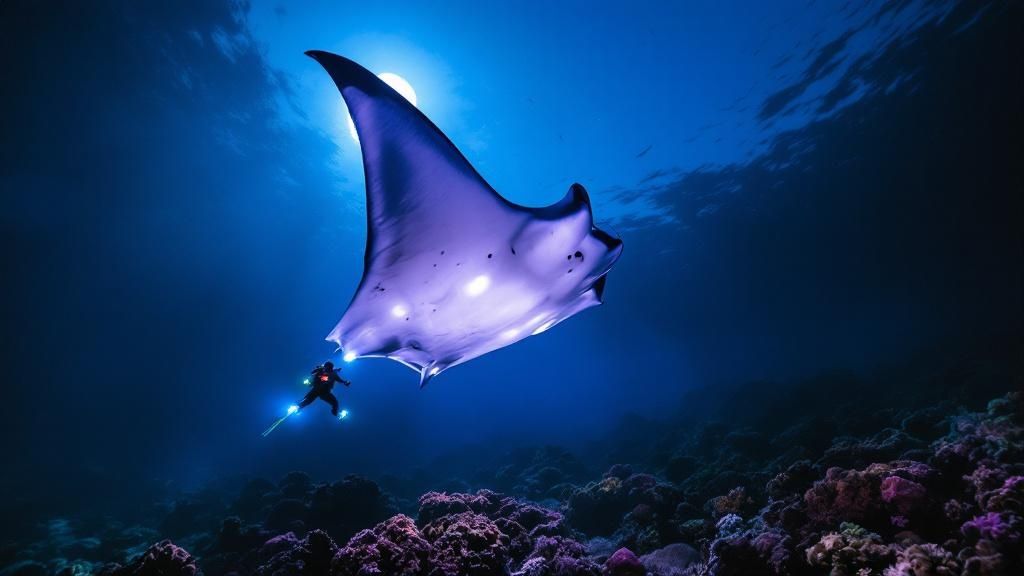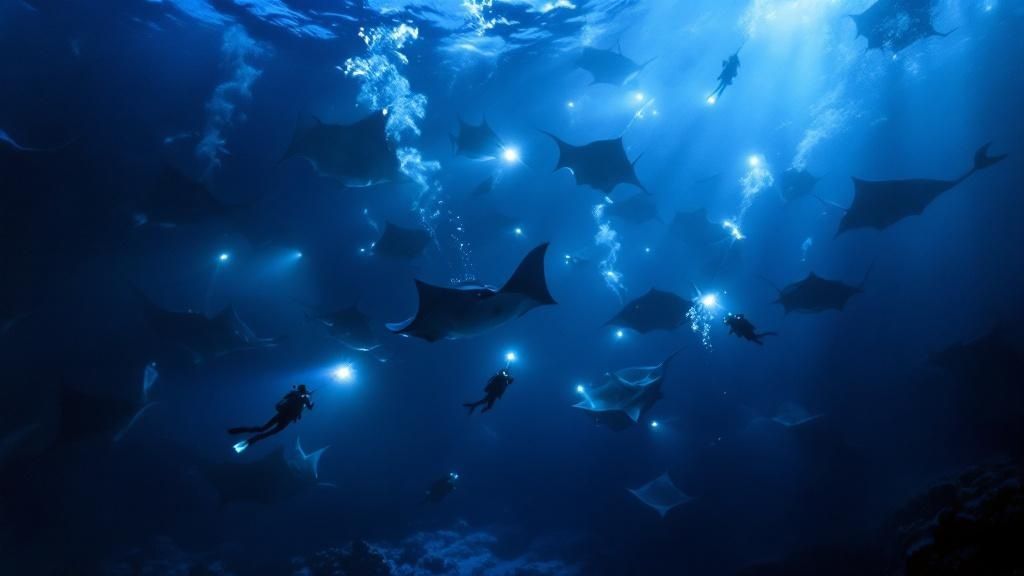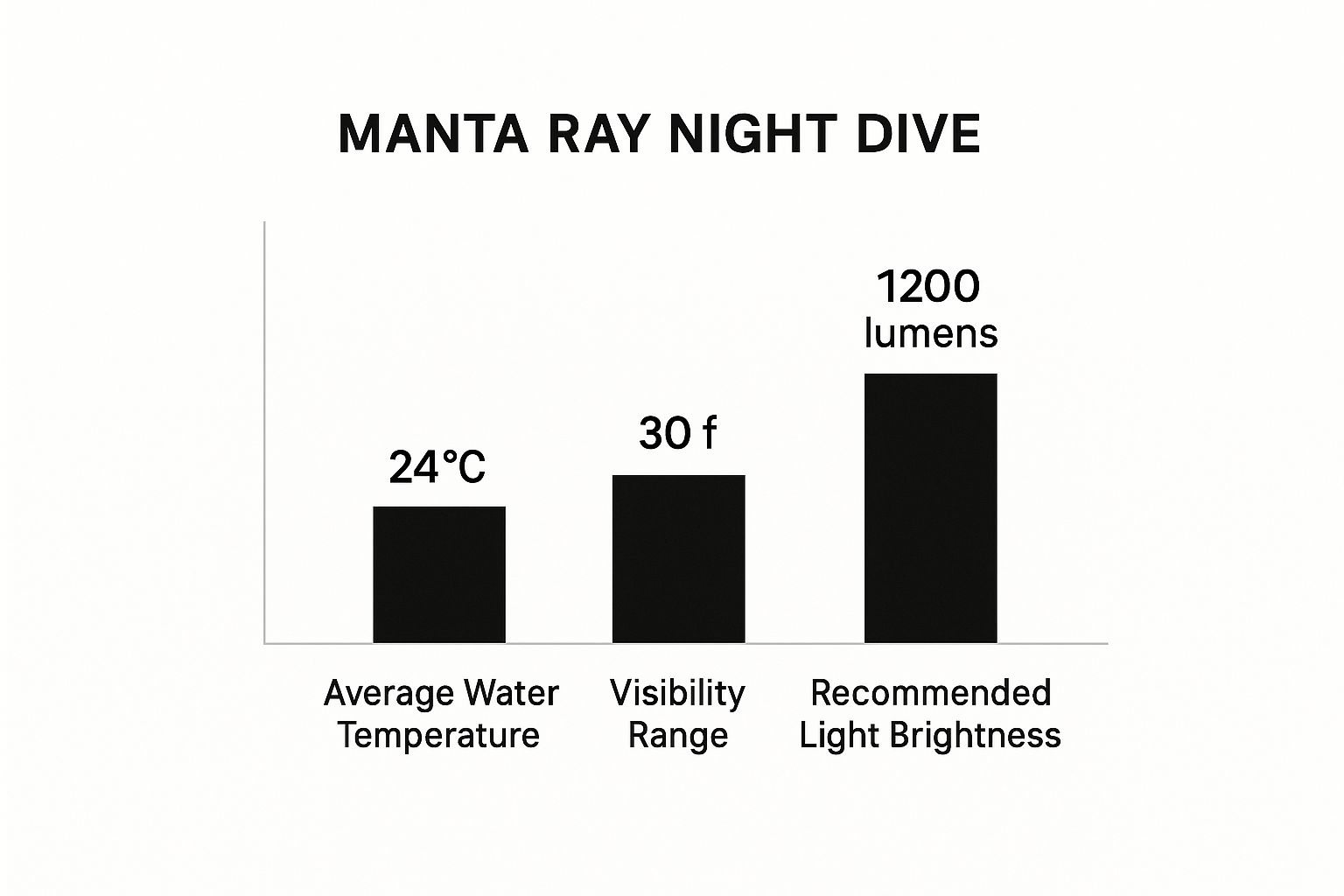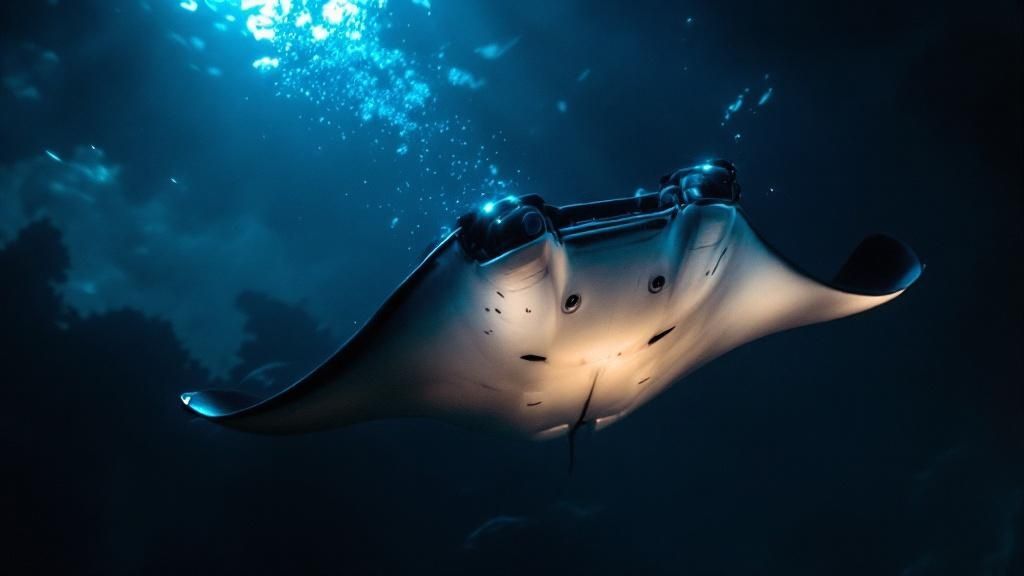Why Kona's Manta Ray Night Dive Feels Like Swimming Through Magic

Imagine floating in the dark Pacific, stars twinkling above. Then, a huge shadow appears, growing until a creature the size of a small car gracefully swims overhead. This is the magic of a manta ray night dive in Kailua-Kona. It's not just seeing these animals; it's witnessing an underwater ballet performed by gentle giants.
This part of the Hawaiian coast provides the perfect setting for this amazing show. The volcanic ocean floor creates sheltered bays ideal for plankton, the manta ray's main food source. The nutrient-rich water attracts huge amounts of plankton, a true feast for the mantas. For underwater photography, an action camera with GoPro beating night vision is great for low-light conditions.
The Dance of the Gentle Giants
The manta ray night dive isn't just about the size and grace of these creatures. It's about their fascinating feeding habits. They perform captivating barrel rolls and flips, a mesmerizing underwater ballet. These movements aren't just for show. They're a very efficient way to filter plankton. The mantas create currents, pulling the plankton closer, allowing them to eat massive amounts in one feeding.
The darkness of night is key to this experience. Special dive lights attract plankton, making a concentrated food source for the mantas. This makes them even easier to see as they move through the illuminated water.
Kona's manta ray night dives are known for reliable sightings. Success rates often range from 85% to over 95% each night. The unique underwater landscape and nutrient-rich waters draw a resident population of over 450 manta rays, with an average wingspan over 12 feet. More on these amazing facts can be found in this Manta Ray Report.
A Transformative Experience
The manta ray night dive is often a life-changing event. It's more than the visual spectacle; it's the feeling of being close to such magnificent creatures. It's a quiet understanding of the delicate balance of the ocean. It's realizing that these gentle giants, despite their size, are vulnerable and need our respect and protection.
This experience stays with divers long after they resurface. Many become passionate about ocean conservation. It shows how nature can inspire awe and respect and reminds us to protect our planet’s resources. The dive creates a lasting memory, a deep connection with the ocean, and a sense of wonder.
The Feeding Frenzy Science That Makes This Experience Possible
Ever wonder why these graceful giants reliably gather in Kailua-Kona? It's not by chance, but rather a fascinating combination of ocean currents, plankton blooms, and the mantas' specialized feeding habits, perfected over millions of years. Picture an underwater banquet, perfectly timed, with the mantas as the distinguished guests.
The menu at this feast, however, is constantly changing, influenced by the moon's cycles, the water temperature, and the life cycles of microscopic plankton.
This "underwater dinner party" wouldn't be possible without the mantas' incredible filter-feeding abilities. These gentle giants can devour up to 60 pounds of plankton in a single night!
They accomplish this through their captivating barrel rolls and somersaults. These movements create currents, drawing the plankton closer, like creating a personalized buffet in the vastness of the ocean. Want a more detailed look at what a manta ray night dive involves? Check out: What Is a Manta Ray Night Dive?
Plankton Superhighways and Manta Strategies
Specific weather patterns add to this feeding frenzy by creating what we can call "plankton superhighways." Think of these as concentrated rivers of plankton carried by particular currents. Mantas, with their highly sensitive sensory systems, detect these plankton-rich streams and position themselves perfectly.
It's less about randomly searching for food and more about strategically placing themselves within these currents. This explains why mantas appear to be gracefully dancing in the water, rather than simply eating. They are actively manipulating the water flow to maximize their plankton intake. Their movements, while beautiful, are actually efficient hunting strategies honed over millennia.
Scientific tracking of individual manta rays reveals further fascinating details. Along the Kona Coast, roughly 120 individual mantas are identified each year. Interestingly, the 20 most frequently sighted individuals account for nearly 60% of all encounters. Over 300 individual manta rays have been cataloged in total, with over 10,000 sightings recorded. Manta ray statistics offer even more insights.
This ongoing research reveals the intricate social structures of these intelligent creatures, including their remarkable ability to recognize individual divers and dive sites. It's a testament to their intelligence and memory, adding another layer of wonder to the manta ray night dive experience in Kailua-Kona.
Getting Ready For An Experience That Will Change How You See The Ocean

Let's face it: witnessing a 14-foot manta ray glide just inches above you on a manta ray night dive in Kailua-Kona is an experience unlike any other. While nothing can truly replicate the awe of that moment, the right preparation can empower you to fully embrace it. This isn't just another dive; it's a journey that requires both mental and physical readiness.
Physical Preparation: More Than Just Your Average Dive
First, let's talk about the physical demands. The manta ray night dive isn't necessarily strenuous, but it does require a comfort level in the water beyond casual snorkeling. You'll be floating in the open ocean at night, sometimes with a current, so buoyancy control is essential. Think of it like cycling at night – you need a solid grasp of the basics to navigate any unexpected turns or obstacles.
Your gear is your next consideration. Night diving calls for specific equipment, especially a dependable dive light, often provided by the dive operator. A well-fitting wetsuit is also vital for staying warm during your extended time in the water. Experienced divers bringing their own gear should ensure everything is properly serviced and ready for night conditions.
Finally, remember the boat ride. Evening trips can be bumpy. If you're susceptible to seasickness, take precautions. Picture a sailor embarking on a night voyage – they check their supplies, prepare their ship, and anticipate changing conditions. You're doing the same, preparing your mind and body for the adventure ahead.
Mental Preparation: Embracing the Wonder
Now, let's shift our focus to the mental aspects. It's perfectly normal to feel a blend of excitement and nerves about encountering these majestic creatures in the dark. Imagine meeting someone you deeply admire – you'd feel the same anticipation and desire to savor the moment.
Managing that excitement underwater is crucial. Excessive movement can disrupt the mantas' feeding and potentially frighten them away. Think of attending a quiet concert: sudden outbursts would shatter the serene atmosphere. The same respect applies to the mantas. Controlled breathing and slow, deliberate movements are key.
Prepare for a sensory feast. The darkness, the dive lights, the graceful ballet of the mantas – it all combines to create a truly powerful experience. Even seasoned guides see first-time divers become completely captivated. It's like stepping into a vibrant festival for the first time – the sheer intensity can be overwhelming. The key is to breathe, stay present, and absorb the wonder gradually. By mentally preparing yourself, you'll be ready to fully embrace the magic of the manta ray night dive in Kailua-Kona.
Choosing Your Dive Operator Like Your Experience Depends On It
Your manta ray night dive in Kailua-Kona is a significant investment, not just financially, but in a truly unforgettable experience. Think of it like choosing a restaurant: you wouldn’t just pick the cheapest one, would you? You'd consider the atmosphere, the service, and of course, the food. Choosing a dive operator is similar. It’s about finding the sweet spot between safety, expertise, and responsible practices. Some operators might cram their boats full, creating an underwater experience that feels more like a crowded highway. Others prioritize smaller, more intimate groups, offering a dive that feels like a private concert with the mantas. This difference profoundly impacts your experience.
Beyond Marketing: What Really Matters
Don't let shiny brochures fool you. Look beyond the surface and investigate each operator’s actual practices. Group size is a major factor. Smaller groups allow for personalized attention from the guides, leading to a more enriching and tailored experience. It's like having a personal tutor versus sitting in a packed lecture hall. Plus, smaller groups are less disruptive to the mantas, letting you witness their natural behavior in a more authentic way. Safety protocols should be non-negotiable, like checking the safety rating of an airline before booking a flight. Ask about emergency procedures, backup lighting, and the guide-to-guest ratio. A seasoned guide with extensive experience can make all the difference in ensuring a safe and enjoyable dive.
Similarly, manta interaction ethics are crucial. Responsible operators put the mantas' well-being first. They educate divers on respectful behavior, discouraging anything that could disturb these gentle giants or their environment. This means maintaining a comfortable distance, avoiding sudden movements, and never attempting to touch the mantas. Ask about the operator's dedication to conservation and education. Do they collaborate with local organizations? Do they advocate for sustainable tourism? Choosing an operator that prioritizes these values not only enriches your dive but also contributes to the long-term protection of these amazing creatures.

The infographic above gives you a snapshot of key information for your manta ray night dive, showing the average water temperature (24°C), visibility (30 feet), and recommended light brightness (1200 lumens). These details help you prepare and understand what to expect. Knowing the water temperature helps you choose the right wetsuit thickness, and understanding the visibility helps you visualize what you might see underwater.
Hidden Gems and Practical Considerations
Besides the main factors, small details can significantly enhance your dive. Think about boat comfort, especially for those evening departures. A spacious boat with comfortable seating can be a game-changer after a day of exploring. Equipment quality matters too. Well-maintained gear ensures your safety and comfort. This includes everything from your wetsuit and mask to your fins and dive light. Finally, inquire about post-dive amenities. Some operators offer hot showers, snacks, and warm drinks, providing a cozy and relaxing environment after your underwater adventure. For more guidance on choosing a dive operator, you might find this helpful: How to choose a Kona dive shop. By carefully considering all these aspects, you’re not just booking a dive; you're creating an unforgettable memory.
To help you compare different operators, we've compiled the following table:
Kona Manta Ray Dive Operator Comparison Guide
Essential comparison of major operators including group sizes, safety protocols, conservation focus, and unique experience features
| Operator | Max Group Size | Experience Level | Dive Duration | Unique Features | Price Range |
|---|---|---|---|---|---|
| Operator A | 6 | Beginner – Advanced | 45-60 minutes | Underwater photography assistance, marine biologist-led tours | $150 – $200 |
| Operator B | 10 | Beginner – Intermediate | 45 minutes | Focus on reef conservation, educational briefings | $120 – $180 |
| Operator C | 8 | Intermediate – Advanced | 60 minutes | Small group experience, personalized attention | $180 – $250 |
| Operator D | 12 | Beginner – Advanced | 40 minutes | Budget-friendly, large boat with amenities | $100 – $150 |
Note: This table is an example and should be populated with real data based on actual Kona dive operators.
This table highlights key differences between operators, allowing you to quickly compare group sizes, experience levels catered to, dive duration, unique features, and price ranges. Choosing the right operator can truly make or break your manta ray night dive experience. Remember to prioritize your comfort level, desired experience, and commitment to responsible tourism when making your decision.
Night Diving Safety And Manta Etiquette That Protects Everyone
Night diving, especially a manta ray night dive in Kailua-Kona, adds a new dimension to the diving experience. It's like exploring a familiar forest at night – everything looks and feels different, requiring a heightened sense of awareness. Factor in the graceful presence of manta rays, and you're in for a truly unique adventure.
Navigating the Darkness: Lights, Communication, and Backups
Imagine walking through a dark room. Your other senses sharpen, and you rely more on touch and sound. Underwater at night, your dive light becomes your primary sense. A primary dive light is essential, illuminating the wonders of the nocturnal underwater world. But what if that light fails? Just like relying on a single headlight at night, it's risky. Always carry a backup light, ideally two, and know how to use them before you descend.
Clear communication with your dive buddy and the boat crew becomes paramount. Think of it like an orchestra playing in the dark; each musician needs to follow the conductor's precise instructions. Pre-arranged hand signals and light signals are your underwater language, ensuring everyone stays coordinated and safe.
Emergency Procedures: Adapting Daytime Skills for Night Conditions
Your daytime diving skills are a foundation, but they need a nighttime upgrade. Buoyancy control, for instance, becomes even more critical. Picture trying to change a tire in the dark – a stable base is essential. Good buoyancy prevents you from accidentally bumping into the reef or, importantly, disturbing the mantas. Practice these skills in a calm environment before heading out for a night dive.
In the rare event of an emergency, staying calm is key. Visual cues are limited, so trust your training and follow established emergency protocols. It’s like having a mental checklist for unexpected situations. Preparation, both mental and physical, helps you confidently handle any challenges. When planning your manta ray night dive, considering checking out resources like Why Should You Go On a Manta Ray Dive in Kona? and general travel blogs like the Aloha Relax Blog for tips on staying calm.
Manta Etiquette: Respect for Gentle Giants
The guidelines for interacting with manta rays aren't just suggestions, they're crucial for protecting both you and these magnificent creatures. Imagine disrupting a beautiful ballet performance by rushing onto the stage. Similarly, inappropriate behavior around mantas disrupts their natural feeding and can cause them stress. Keeping a respectful distance, avoiding sudden movements, and never attempting to touch them allows these gentle giants to continue their mesmerizing dance undisturbed.
Managing Anxiety: Techniques for Calm and Enjoyment
Night diving, particularly your first time, might bring some anxiety. But this feeling often stems from the unfamiliar, not inherent danger. Think of it like public speaking – practice and preparation transform nerves into excitement. Focusing on your breathing, maintaining positive self-talk, and trusting your training will calm your mind, letting you fully appreciate the magic of the experience. The manta ray night dive in Kailua-Kona is a unique privilege. Respectful interaction ensures the well-being of these gentle giants and creates a truly unforgettable memory.
What Actually Happens When You're Surrounded By Gentle Giants
Imagine the sun setting over the Pacific, painting the sky in vibrant oranges and purples, as your boat heads towards the dive site. A quiet excitement fills the air. This is just the start of a manta ray night dive in Kailua-Kona, an experience you won't soon forget. Intrigued? You can learn more about the manta ray night dive in the Big Island.
The Underwater Stage Is Set
Once at the dive site, the crew begins the almost ritualistic process of setting up the lights. These aren't your average dive lights; they're the heart of the whole show. Think of them as underwater spotlights, attracting the tiny organisms that make up the manta rays' diet. As you descend into the warm Hawaiian waters, the lights reveal a captivating scene: plankton, illuminated by the beams, swirling in the current like a living snow globe.
The Gentle Giants Arrive
The true magic starts when the manta rays appear. That first shadow gliding overhead, growing larger and larger until it transforms into a magnificent creature, is a breathtaking moment. It's similar to watching a jumbo jet soaring through the air, but you're underwater, and this "jet" is a living, breathing wonder of nature. Speaking of being prepared on the water, safety is key. A reliable Gme GX625 5w Vhf Marine Radio can add an extra layer of security.
The sensation of the water moving from their powerful wing beats is surprising, a gentle pulse that reminds you of the sheer size of these animals. Despite weighing over 3,000 pounds, they move with unbelievable grace, their movements creating an almost hypnotic dance. These nightly dives, typically lasting 45 to 60 minutes, are timed perfectly with the manta rays' feeding schedule. Plankton, drawn by the specialized lights, gathers in dense clouds near the surface. This orchestrated event attracts about 80,000 participants annually. For a deeper dive into this incredible spectacle, discover more insights about the Kona manta ray night dive.
A Dance of Personalities
Each manta ray has its own unique character. Some are reserved, keeping a comfortable distance from the divers. Others show a playful curiosity, seeming fascinated by the strange bubble-blowing visitors in their dining area. These close encounters, where you can see the intricate details of their markings and the subtle expressions in their movements, are what truly sets the manta ray night dive apart. It's not just about observing animals; it's about connecting with them in their natural habitat, witnessing a timeless dance that has continued for millennia. It's a transformative experience that changes your perspective on the ocean, leaving you with a sense of awe and a deeper appreciation for the delicate balance of marine life.
Capturing The Magic And Supporting Conservation Beyond Your Dive

Your manta ray night dive in Kailua-Kona isn't just an exciting adventure; it's a chance to connect with these gentle giants and their ocean home on a deeper level. Many divers find this experience sparks a desire to protect these amazing creatures.
Preserving the Memory: Photography Tips for the Manta Ray Ballet
You'll naturally want to capture the magic of this encounter. But doing so responsibly, without disturbing the mantas, is key. Think of it like photographing a hummingbird in mid-air – sudden movements can easily disrupt its graceful flight.
For those low-light conditions, your camera settings are crucial. A higher ISO, wider aperture, and slower shutter speed will help capture the mantas' ethereal glow. But be aware, a slower shutter speed can blur images if the mantas are moving quickly. It’s all about finding the right balance. Experiment to see what works best with your camera. Positioning is important too. Don't get too close or obstruct their path. Imagine yourself as a respectful observer at a wildlife sanctuary, giving the animals their space.
To help you further, here's a handy guide for your underwater photography adventure:
Manta Ray Photography Guide For Night Diving
Camera settings, positioning techniques, and ethical guidelines for capturing stunning manta encounters without disrupting natural behavior
| Camera Type | Recommended Settings | Lighting Setup | Positioning Tips | Ethical Guidelines |
|---|---|---|---|---|
| DSLR | ISO 800-1600, f/2.8-f/4, 1/60-1/125 sec | External strobe or video light with red filter | Stay below the mantas, avoid flash if possible | Do not touch or chase the mantas, respect their space |
| Mirrorless | ISO 800-1600, f/2.8-f/4, 1/60-1/125 sec | External strobe or video light with red filter | Position yourself slightly to the side for unobstructed views | Keep a safe distance, avoid sudden movements |
| Compact/Action | ISO 400-800, f/2.8-f/4, 1/30-1/60 sec | Built-in flash with diffuser or red filter if possible | Maintain a steady position to minimize blur | Do not use flash if it appears to distress the mantas |
This table provides general recommendations. The best settings will vary depending on your specific camera and the conditions of the dive. Remember, prioritizing the well-being of the mantas is paramount.
Beyond the Lens: Conservation Challenges and Your Role
Manta rays face various threats, including plastic pollution clogging their feeding filters and entanglement in fishing gear. These issues demand ongoing research and conservation work. Your dive, perhaps without you realizing it, contributes directly to these efforts. Many dive operators donate a portion of their fees to local conservation and research organizations.
But your contribution doesn't have to stop there. Citizen science provides avenues for you to directly participate in research. You can contribute to photo identification projects, helping researchers track individual mantas and their movements to better understand population dynamics. Documenting manta ray behavior, such as feeding habits and social interactions, also adds valuable data.
For those interested in the best time to experience these majestic creatures, this article might be helpful: What is the best time of year to see manta rays in Kona?
Sharing the Magic: Responsible Social Media and Continued Engagement
Sharing your experience on social media can inspire others to appreciate and protect these amazing animals. But it's important to do so responsibly. Avoid geotagging specific dive sites, as this can lead to overcrowding and disturb the mantas’ natural habitat. Focus on sharing the beauty of the experience and promoting ethical wildlife tourism.
Your connection with manta ray conservation doesn't end when you leave Kailua-Kona. Many organizations are dedicated to protecting these gentle giants. Supporting their work through donations or volunteering can make a real difference. Staying informed about ongoing research and conservation efforts allows you to become a lifelong advocate.
Experience the magic of the manta ray night dive with Kona Honu Divers. We're dedicated to sustainable dive experiences that contribute to the long-term protection of these gentle giants. Book your unforgettable adventure today!
